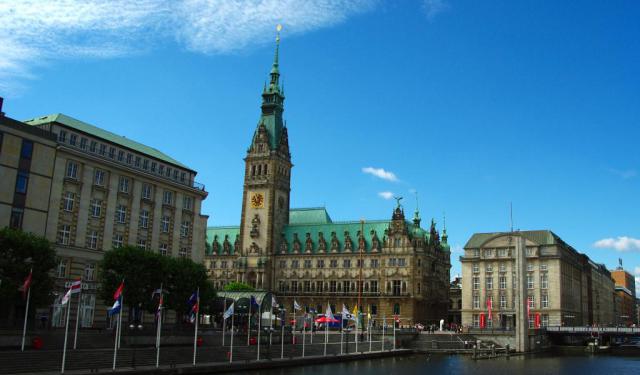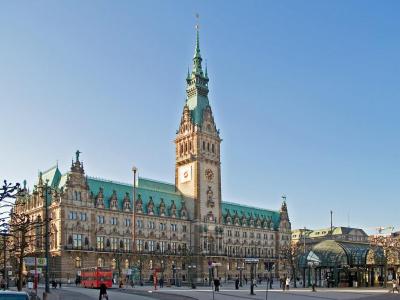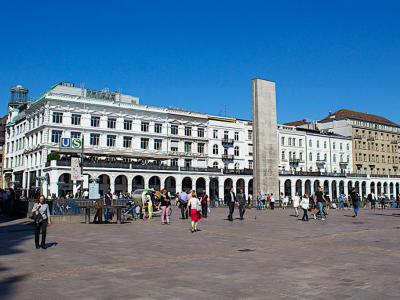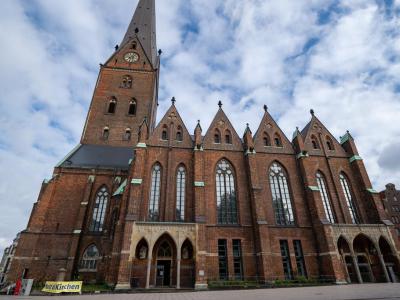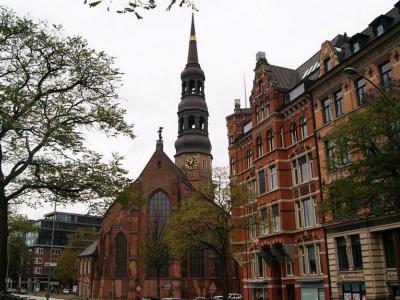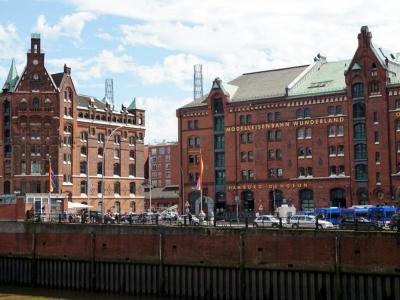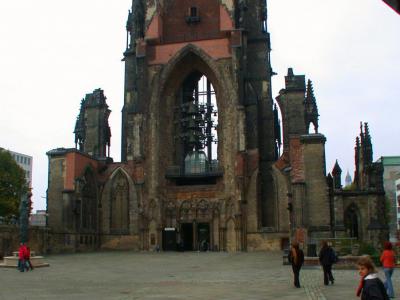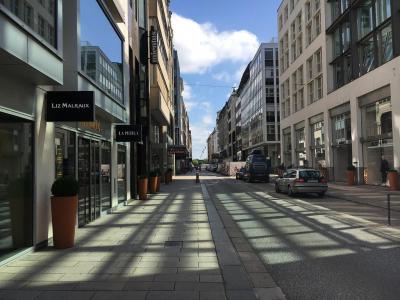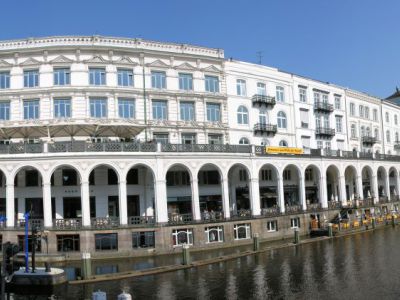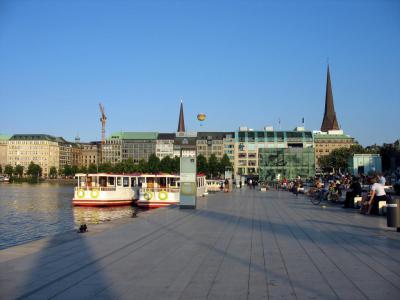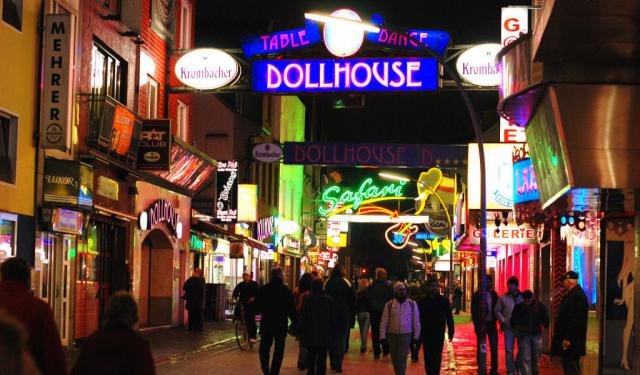Hamburg Introduction Walking Tour (Self Guided), Hamburg
Hamburg is one of Germany's largest cities, second only to Berlin. It is also Europe's third-largest port. The city has a population of over 1.8 million, and the metropolitan area is home to over five million people. Its official name is the Free and Hanseatic City of Hamburg. This name reflects its historical membership in the medieval Hanseatic League and one of the Holy Roman Empire's free imperial cities.
Hamburg acted as a sovereign city-state until Germany's unification in 1871. The city has faced many hardships, such as the Great Fire of 1842, intense bombing during World War II, and the North Sea flood of 1962. After each disaster, Hamburg has bounced back and regained its vibrancy.
Hamburg boasts the world's oldest merchant bank and Germany's first stock exchange. In addition, many German, European, and multinational companies are based in Hamburg.
Hamburg features World Heritage sites. The river and canal system is impressive, and the city has a beautiful architectural heritage. The city also is known for launching The Beatle's musical career.
Hamburg City Hall features an impressive exterior and elaborately decorated interior. St. Peter's Church was rebuilt after the Great Fire of 1842. The church features many important artworks that were salvaged after the fire. Visitors will admire St. Catherine's Church's ancient spire, which can be seen from all over the city. The Church of St. Nicholas was heavily damaged during World War II, but visitors can still view the tower or take an elevator to an elevated viewing platform.
Don't miss the Waterhouse District, listed as a UNESCO World Heritage Site. Visitors can admire the fabulous architecture and dedication to port infrastructure.
Miniature Wonderland is Germany's top tourist attraction. The technology and detail will enthrall visitors as trains, planes, and gondolas meander through recreated miniature cities and countries.
Take this self-guided walking tour and enjoy Hamburg's history and culture.
Hamburg acted as a sovereign city-state until Germany's unification in 1871. The city has faced many hardships, such as the Great Fire of 1842, intense bombing during World War II, and the North Sea flood of 1962. After each disaster, Hamburg has bounced back and regained its vibrancy.
Hamburg boasts the world's oldest merchant bank and Germany's first stock exchange. In addition, many German, European, and multinational companies are based in Hamburg.
Hamburg features World Heritage sites. The river and canal system is impressive, and the city has a beautiful architectural heritage. The city also is known for launching The Beatle's musical career.
Hamburg City Hall features an impressive exterior and elaborately decorated interior. St. Peter's Church was rebuilt after the Great Fire of 1842. The church features many important artworks that were salvaged after the fire. Visitors will admire St. Catherine's Church's ancient spire, which can be seen from all over the city. The Church of St. Nicholas was heavily damaged during World War II, but visitors can still view the tower or take an elevator to an elevated viewing platform.
Don't miss the Waterhouse District, listed as a UNESCO World Heritage Site. Visitors can admire the fabulous architecture and dedication to port infrastructure.
Miniature Wonderland is Germany's top tourist attraction. The technology and detail will enthrall visitors as trains, planes, and gondolas meander through recreated miniature cities and countries.
Take this self-guided walking tour and enjoy Hamburg's history and culture.
How it works: Download the app "GPSmyCity: Walks in 1K+ Cities" from Apple App Store or Google Play Store to your mobile phone or tablet. The app turns your mobile device into a personal tour guide and its built-in GPS navigation functions guide you from one tour stop to next. The app works offline, so no data plan is needed when traveling abroad.
Hamburg Introduction Walking Tour Map
Guide Name: Hamburg Introduction Walking Tour
Guide Location: Germany » Hamburg (See other walking tours in Hamburg)
Guide Type: Self-guided Walking Tour (Sightseeing)
# of Attractions: 10
Tour Duration: 2 Hour(s)
Travel Distance: 3.1 Km or 1.9 Miles
Author: DanaOffice
Sight(s) Featured in This Guide:
Guide Location: Germany » Hamburg (See other walking tours in Hamburg)
Guide Type: Self-guided Walking Tour (Sightseeing)
# of Attractions: 10
Tour Duration: 2 Hour(s)
Travel Distance: 3.1 Km or 1.9 Miles
Author: DanaOffice
Sight(s) Featured in This Guide:
- Hamburger Rathaus (Hamburg City Hall)
- Rathausmarkt (City Hall Marketplace)
- St. Peter's Church
- St. Catherine's Church
- Speicherstadt (Warehouse District)
- Miniature Wonderland
- Church of St. Nicholas
- Neuer Wall (New Wall Street)
- Alsterarkaden (Alster Arcade)
- Jungfernstieg (Alster Lake Promenade)
1) Hamburger Rathaus (Hamburg City Hall) (must see)
The old city hall was destroyed in 1842, and it took until 1897 for the new city hall to be inaugurated. Hamburg City Hall's exterior has a Neo-Renaissance style. This massive building has an interior area of 17,000 square meters (182,986 square feet). The tower is 112 meters (367 feet) tall.
The new city hall was built to show Hamburg's immense wealth and prosperity. It is the seat of Hamburg's parliament, mayor, and senate. Heads of State such as Emperor Haile Salassie I, Mohammed Reza Pahlavi, and Queen Elizabeth II have been received in this impressive building.
The building's elaborate facade features 20 statues of emperors. The main entrance features a wrought iron gate. Don't miss the entrance hall's 16 sandstone pillars. Portraits adorning the pillars represent 68 Hamburg citizens. The imposing Sardinian marble staircase depicts the journey of life.
The Imperial Hall has a painted ceiling that depicts German merchant shipping, while pressed leather wall coverings decorate the walls. A phoenix representing Hamburg's recovery after the 1842 fire stands above the fireplace in Phoenix Hall.
The Senate chamber features a glass roof that fills the chamber with light and represents ancient open-air council meetings.
In the Grand Ballroom, visitors will find enormous paintings showing Hamburg's history from 800 to 1900. The impressive chandeliers have 278 lights each.
Hamburg City Hall's lobby is open to the public and is used for exhibitions and concerts. The balcony features a mosaic featuring the city's coat of arms and motto and depicts Hamburg's patron goddess Hammonia.
The courtyard features a fountain representing Hygieia, the Greek goddess of health and hygiene.
The new city hall was built to show Hamburg's immense wealth and prosperity. It is the seat of Hamburg's parliament, mayor, and senate. Heads of State such as Emperor Haile Salassie I, Mohammed Reza Pahlavi, and Queen Elizabeth II have been received in this impressive building.
The building's elaborate facade features 20 statues of emperors. The main entrance features a wrought iron gate. Don't miss the entrance hall's 16 sandstone pillars. Portraits adorning the pillars represent 68 Hamburg citizens. The imposing Sardinian marble staircase depicts the journey of life.
The Imperial Hall has a painted ceiling that depicts German merchant shipping, while pressed leather wall coverings decorate the walls. A phoenix representing Hamburg's recovery after the 1842 fire stands above the fireplace in Phoenix Hall.
The Senate chamber features a glass roof that fills the chamber with light and represents ancient open-air council meetings.
In the Grand Ballroom, visitors will find enormous paintings showing Hamburg's history from 800 to 1900. The impressive chandeliers have 278 lights each.
Hamburg City Hall's lobby is open to the public and is used for exhibitions and concerts. The balcony features a mosaic featuring the city's coat of arms and motto and depicts Hamburg's patron goddess Hammonia.
The courtyard features a fountain representing Hygieia, the Greek goddess of health and hygiene.
2) Rathausmarkt (City Hall Marketplace)
This area was heavily damaged during the Great Fire of Hamburg in 1842. Venice's Piazza San Marco inspired the new square's design. The impressive City Hall dominates the square.
City Hall Marketplace was known as Adolf Hitler square from 1933-1945. The square acted as the transport hub for the Hamburg tram network until the 1970s. After the trams ceased operating, the square was renovated.
City Hall Marketplace hosts a variety of festivals and events throughout the year. In the summer, visitors can enjoy the wine village featuring select wines and delicious treats. An open-air cinema is another popular draw during the summer months.
A festive Christmas market is a popular experience during the holiday season. Holiday visitors can enjoy beautiful lights, hot chocolate, hot rum, mulled wine, bratwurst, and currywurst as they shop at the delightful Christmas market.
Visitors can also see the monument to Heinrich Heine, an influential German poet.
City Hall Marketplace was known as Adolf Hitler square from 1933-1945. The square acted as the transport hub for the Hamburg tram network until the 1970s. After the trams ceased operating, the square was renovated.
City Hall Marketplace hosts a variety of festivals and events throughout the year. In the summer, visitors can enjoy the wine village featuring select wines and delicious treats. An open-air cinema is another popular draw during the summer months.
A festive Christmas market is a popular experience during the holiday season. Holiday visitors can enjoy beautiful lights, hot chocolate, hot rum, mulled wine, bratwurst, and currywurst as they shop at the delightful Christmas market.
Visitors can also see the monument to Heinrich Heine, an influential German poet.
3) St. Peter's Church
A cathedral has existed on this site for centuries. Records indicate that Saint Peter's was built in the late 12th century before being rebuilt in the Gothic style during the 1300s. The most important Saint Peter's artifacts are the bronze lion-head door handles, which date to 1342.
Saint Peter's Church was heavily damaged in the Great Fire of 1842. However, many of the artworks, including the lion-head door handles, were saved.
After the fire, the church was rebuilt. The 132-meter-tall (433 foot) tower was completed in 1878.
Inside the church, visitors will find many important artworks. A 1460 Gothic mural shows the church's first bishop, Ansgar of Bremen. A statue created in the late 1400s also depicts Ansgar of Bremen. Two 17th century Gottfried Libalt paintings, Jacob's Dream and Christ's Birth are on display in the cathedral.
Another important painting is Christams 1813 in Saint Peter's. This painting depicts the Hamburg citizens locked in the church for refusing to feed Napolean's occupying troops.
Visitors are welcome to climb the 544 steps to the church's viewing platform. This is the highest viewing platform in the city, and guests can look out over the city center, Alster Lake, and the port.
Saint Peter's Church was heavily damaged in the Great Fire of 1842. However, many of the artworks, including the lion-head door handles, were saved.
After the fire, the church was rebuilt. The 132-meter-tall (433 foot) tower was completed in 1878.
Inside the church, visitors will find many important artworks. A 1460 Gothic mural shows the church's first bishop, Ansgar of Bremen. A statue created in the late 1400s also depicts Ansgar of Bremen. Two 17th century Gottfried Libalt paintings, Jacob's Dream and Christ's Birth are on display in the cathedral.
Another important painting is Christams 1813 in Saint Peter's. This painting depicts the Hamburg citizens locked in the church for refusing to feed Napolean's occupying troops.
Visitors are welcome to climb the 544 steps to the church's viewing platform. This is the highest viewing platform in the city, and guests can look out over the city center, Alster Lake, and the port.
4) St. Catherine's Church
Saint Catherine's Church features an ancient spire and extensive history. Saint Catherine's is one of Hamburg's five historic Lutheran churches. The church's spire dates to 1256. The church was rebuilt in the German Brick Gothic style in the mid-15th century. An elaborate Baroque rooftop was added to the spire in 1657. This increased the spire's height to 115 meters (377 feet).
World War II bombs heavily damaged the church. Only the base of the spire and outer walls were left intact. Saint Catherine's Church was rebuilt in the 1950s, and the steeple was restored with steel and copper. Catherine's crown sits on top of the impressive steeple.
During the 1700s, Saint Catherine's Church was home to one of the largest organs in the world. Famed musician and composer Johann Sebastian Bach once played the beautiful organ. Along with the church, the organ was heavily damaged by WWII bombs but has been restored.
The church hosts a weekly market on Tuesdays in the church square.
World War II bombs heavily damaged the church. Only the base of the spire and outer walls were left intact. Saint Catherine's Church was rebuilt in the 1950s, and the steeple was restored with steel and copper. Catherine's crown sits on top of the impressive steeple.
During the 1700s, Saint Catherine's Church was home to one of the largest organs in the world. Famed musician and composer Johann Sebastian Bach once played the beautiful organ. Along with the church, the organ was heavily damaged by WWII bombs but has been restored.
The church hosts a weekly market on Tuesdays in the church square.
5) Speicherstadt (Warehouse District) (must see)
Hamburg's Warehouse District is one of the most impressive warehouse districts in the world where the buildings stand on timber-pile foundations. The warehouses were built between 1883 and 1927 as a customs-free zone. The site is a UNESCO World Heritage Site.
The warehouses were built directly into the Elbe waterway, allowing for waterside access and easy ship unloading and loading. Waterways between the buildings act as canals.
The warehouse's facades are Neo-Gothic and feature red brick with towers, alcoves, and ornaments. The warehouses are each seven or eight stories tall and have landside and waterside entrances. Today, the warehouses are used as warehouses, museums, and home to the Minature Wonderland.
Visitors should check out the water castle on Dutch Bridge for a popular photo spot. Café Fleetschlösschen offers another scenic vista and cafe. The Warehouse District is beautiful at dusk as the lights come on and reflect in the canals.
The warehouses were built directly into the Elbe waterway, allowing for waterside access and easy ship unloading and loading. Waterways between the buildings act as canals.
The warehouse's facades are Neo-Gothic and feature red brick with towers, alcoves, and ornaments. The warehouses are each seven or eight stories tall and have landside and waterside entrances. Today, the warehouses are used as warehouses, museums, and home to the Minature Wonderland.
Visitors should check out the water castle on Dutch Bridge for a popular photo spot. Café Fleetschlösschen offers another scenic vista and cafe. The Warehouse District is beautiful at dusk as the lights come on and reflect in the canals.
6) Miniature Wonderland (must see)
Miniature Wonderland features the world's largest model railway. The railway has over 15,715 meters (51,558 feet) of track. There are over 1,000 trains, 100,000 vehicles, 385,000 lights, 260,000 figurines, and 130,000 trees.
Visitors will be awed by the different beautiful scenes. The fictitious city of Knuffingen joins the Alps, Austria, America, South America, Scandinavia, Switzerland, Italy, Hamburg, and Hamburg airport. Monaco & the Provence are currently under construction. Visitors are welcome to watch technicians put together the new attraction, piece by piece.
Visitors can walk between different rooms by following the corridor. Visitors will see the beautiful Harz region, along with central and southern Germany. Additional features included the ICE high-speed road and a new Fun Fair with 150 attractions.
Knuffingen, the fictional town, features a road system with moving cars. Austria features the Aplas and a multi-level helix. Visitors can watch trains switch above their heads. Hamburg is the biggest city in Wonderland. One thousand five hundred trains arrive in Wonderland's Hamburg every day, and all the famous sites are on display.
The USA display features Las Vegas, which is lit by 33,000 lights. In addition, visitors can travel to Cape Canaveral, the famed Florida Keys, the Grand Canyon, Mount Rushmore, and Yosemite National Park.
The Scandinavian section features ships navigating real waterways. The ships are steered manually across the North and Baltic Sea. To recreate the dramatic seascape, the tides switch every 25 minutes.
The Swiss Alps reach up to six meters tall. Visitors can reach the second level via stairs and watch trains negotiate the steep switchbacks.
Knuffingen Airport is a sight to behold with impressive technology controlling different aircraft and vehicle movements.
The Italy section features Rome and Tuscany. Visitors can watch Vesuvius spew lava. Venice is one of Wonderland's most elaborate sections. One hundred fifty gondolas travel under 26 bridges, while Venice's gorgeous architecture is beautifully recreated.
Why You Should Visit:
Miniature Wonderland is consistently rated as Germany's top tourist attraction. The attention to detail is incredible, and visitors of all ages will be enthralled by these miniature cities with thousands of moving trains, vehicles, and figurines.
Tips:
Backstage Tours offer insight into how technology works to keep the trains and attractions moving. Weekdays are the best time to visit to avoid crowds.
Visitors will be awed by the different beautiful scenes. The fictitious city of Knuffingen joins the Alps, Austria, America, South America, Scandinavia, Switzerland, Italy, Hamburg, and Hamburg airport. Monaco & the Provence are currently under construction. Visitors are welcome to watch technicians put together the new attraction, piece by piece.
Visitors can walk between different rooms by following the corridor. Visitors will see the beautiful Harz region, along with central and southern Germany. Additional features included the ICE high-speed road and a new Fun Fair with 150 attractions.
Knuffingen, the fictional town, features a road system with moving cars. Austria features the Aplas and a multi-level helix. Visitors can watch trains switch above their heads. Hamburg is the biggest city in Wonderland. One thousand five hundred trains arrive in Wonderland's Hamburg every day, and all the famous sites are on display.
The USA display features Las Vegas, which is lit by 33,000 lights. In addition, visitors can travel to Cape Canaveral, the famed Florida Keys, the Grand Canyon, Mount Rushmore, and Yosemite National Park.
The Scandinavian section features ships navigating real waterways. The ships are steered manually across the North and Baltic Sea. To recreate the dramatic seascape, the tides switch every 25 minutes.
The Swiss Alps reach up to six meters tall. Visitors can reach the second level via stairs and watch trains negotiate the steep switchbacks.
Knuffingen Airport is a sight to behold with impressive technology controlling different aircraft and vehicle movements.
The Italy section features Rome and Tuscany. Visitors can watch Vesuvius spew lava. Venice is one of Wonderland's most elaborate sections. One hundred fifty gondolas travel under 26 bridges, while Venice's gorgeous architecture is beautifully recreated.
Why You Should Visit:
Miniature Wonderland is consistently rated as Germany's top tourist attraction. The attention to detail is incredible, and visitors of all ages will be enthralled by these miniature cities with thousands of moving trains, vehicles, and figurines.
Tips:
Backstage Tours offer insight into how technology works to keep the trains and attractions moving. Weekdays are the best time to visit to avoid crowds.
7) Church of St. Nicholas
The Church of Saint Nicolas was originally built in 1195. A brick building replaced the wooden structure during the 14th century.
The Church of Saint Nicholas was the center of many theological debates during the Reformation. Conservative council members were concerned about the new wave of Lutheran ministers; however, the Reformation in Hamburg was peaceful. Johannes Bugenhagen, a Lutheran minister, became Saint Nicholas's preacher in 1528.
The Church of Saint Nicolas was one of the first public buildings to burn in Hamburg's catastrophic 1842 Great Fire. After the fire, the church was rebuilt in Neo-Gothic style. From 1874 to 1876, the rebuilt church with its 147-meter-high (483-foot) tower was the tallest building in the world.
Unfortunately, World War II bombs weakened the church's structure. Hamburg decided to demolish most of the church instead of attempting reconstruction. Today, the crypt and spired tower remain. An elevator was installed in 2005 and takes visitors to a 75-meter-tall (247-foot) viewing platform. The platform overlooks Hamburg's city center, the Alster lakes, and the port.
Guests can visit the WWII museum in the church's crypt. The museum offers different interactive displays that show the war's destruction and reconstruction.
The Church of Saint Nicholas was the center of many theological debates during the Reformation. Conservative council members were concerned about the new wave of Lutheran ministers; however, the Reformation in Hamburg was peaceful. Johannes Bugenhagen, a Lutheran minister, became Saint Nicholas's preacher in 1528.
The Church of Saint Nicolas was one of the first public buildings to burn in Hamburg's catastrophic 1842 Great Fire. After the fire, the church was rebuilt in Neo-Gothic style. From 1874 to 1876, the rebuilt church with its 147-meter-high (483-foot) tower was the tallest building in the world.
Unfortunately, World War II bombs weakened the church's structure. Hamburg decided to demolish most of the church instead of attempting reconstruction. Today, the crypt and spired tower remain. An elevator was installed in 2005 and takes visitors to a 75-meter-tall (247-foot) viewing platform. The platform overlooks Hamburg's city center, the Alster lakes, and the port.
Guests can visit the WWII museum in the church's crypt. The museum offers different interactive displays that show the war's destruction and reconstruction.
8) Neuer Wall (New Wall Street)
New Wall (Neuer Wall) is a high-end shopping street in Hamburg's Neustadt district, running from Jungfernstieg by Lake Binnenalster to Townhouse Bridge (Stadthausbrücke). Positioned between Bleichenfleet Canal and Alster River, it features notable landmarks such as the 1710 Görtz Palace and the 1864 Mellin-Passage, a historic shopping arcade connected to Alster Arcades.
New Wall Street is widely regarded as one of the most exclusive shopping destinations in Europe. Its 1,200 meters of shop-fronts are almost entirely dedicated to luxury brands, making it a magnet for discerning shoppers seeking top-tier fashion, jewelry, and designer goods. The street's refined atmosphere, enhanced by a recent extensive refurbishment, perfectly complements the sophisticated stores that line its broad sidewalks.
Prominent international designers and luxury brands are well-represented along the New Wall. Shoppers can explore boutiques of famed labels such as Escada, Jil Sander, Joop!, Gucci, Louis Vuitton, and St. Emile.
Additionally, the street offers bespoke fashion from Akris and Liz Malraux, luxury writing instruments at Montblanc, avant-garde eyewear at Brille Vue, and vibrant jewelry at Frey Wille. For a comprehensive shopping experience, Unger presents over a hundred designer collections within a sprawling 1,000-square-meter space.
New Wall's appeal lies not only in its array of high-end products but also in its well-maintained environment that ensures an exclusive and enjoyable shopping experience. Whether seeking exclusive accessories, designer furniture, or luxury fashion, New Wall promises a retail adventure that is both sophisticated and satisfying.
New Wall Street is widely regarded as one of the most exclusive shopping destinations in Europe. Its 1,200 meters of shop-fronts are almost entirely dedicated to luxury brands, making it a magnet for discerning shoppers seeking top-tier fashion, jewelry, and designer goods. The street's refined atmosphere, enhanced by a recent extensive refurbishment, perfectly complements the sophisticated stores that line its broad sidewalks.
Prominent international designers and luxury brands are well-represented along the New Wall. Shoppers can explore boutiques of famed labels such as Escada, Jil Sander, Joop!, Gucci, Louis Vuitton, and St. Emile.
Additionally, the street offers bespoke fashion from Akris and Liz Malraux, luxury writing instruments at Montblanc, avant-garde eyewear at Brille Vue, and vibrant jewelry at Frey Wille. For a comprehensive shopping experience, Unger presents over a hundred designer collections within a sprawling 1,000-square-meter space.
New Wall's appeal lies not only in its array of high-end products but also in its well-maintained environment that ensures an exclusive and enjoyable shopping experience. Whether seeking exclusive accessories, designer furniture, or luxury fashion, New Wall promises a retail adventure that is both sophisticated and satisfying.
9) Alsterarkaden (Alster Arcade)
Alster Arcade (Alsterarkaden) in Hamburg is a picturesque shopping destination that combines architectural elegance with the serene ambiance of Hamburg's waterways. Designed by Alexis de Chateauneuf, a pioneering urban planner, the arcade was built in 1846 as part of the city's reconstruction following the Great Fire of 1842. The Alster Arcade, with its bright white arches reminiscent of Venice, offers a stunning reflection in the waters of the Inner Alster Lake, particularly enchanting at dusk when the city lights twinkle on the water.
The arcade's design features curved arches and Mediterranean charm, reflecting Chateauneuf's inspiration from his travels to Italy. This design not only revitalized the Jungfernstieg waterfront but also established an exclusive area for shopping, dining, and socializing amidst grandeur. The covered walkways provide shade and shelter, allowing for year-round enjoyment of the area, whether for a stroll or relaxing at one of the charming cafes along the canal.
Shopping at the Alster Arcade is a luxury experience with designer boutiques, exclusive jewelry stores, and high-end dining options. The Mellin Passage, the oldest shopping arcade in Hamburg connected to the Alster Arcade, offers unique finds such as antiques, rare books, and exquisite porcelain. Notably, a fire in 1989 led to the discovery of hidden Art Nouveau frescoes and stained glass in one of the Mellin Passage shops, adding an element of historical intrigue to the arcade.
The Alster Arcade is also home to cultural symbols like the white and black swans gliding across the Inner Alster Lake, a sight that holds significant cultural importance in Hamburg. The presence of these swans is intertwined with the city's identity, symbolizing Hamburg's enduring freedom and status as a Hanseatic city.
The arcade's design features curved arches and Mediterranean charm, reflecting Chateauneuf's inspiration from his travels to Italy. This design not only revitalized the Jungfernstieg waterfront but also established an exclusive area for shopping, dining, and socializing amidst grandeur. The covered walkways provide shade and shelter, allowing for year-round enjoyment of the area, whether for a stroll or relaxing at one of the charming cafes along the canal.
Shopping at the Alster Arcade is a luxury experience with designer boutiques, exclusive jewelry stores, and high-end dining options. The Mellin Passage, the oldest shopping arcade in Hamburg connected to the Alster Arcade, offers unique finds such as antiques, rare books, and exquisite porcelain. Notably, a fire in 1989 led to the discovery of hidden Art Nouveau frescoes and stained glass in one of the Mellin Passage shops, adding an element of historical intrigue to the arcade.
The Alster Arcade is also home to cultural symbols like the white and black swans gliding across the Inner Alster Lake, a sight that holds significant cultural importance in Hamburg. The presence of these swans is intertwined with the city's identity, symbolizing Hamburg's enduring freedom and status as a Hanseatic city.
10) Jungfernstieg (Alster Lake Promenade)
Alster Lake Promenade (Jungfernstieg), located in Hamburg, is a prominent urban promenade renowned for its scenic location and historical significance. Spanning approximately 600 meters, it traces the southern and southwestern shores of the Binnenalster Lake, extending from Ballindamm near the Europa Passage shopping center in the east to Neuer Jungfernstieg in the west. This area transitions smoothly into Gänsemarkt, blending commercial vibrancy with the tranquility of the lakeside.
Originally developed in 1235 when Count Adolph IV of Holstein established a mill dam on the Alster River, the Alster Lake Promenade area evolved from a practical mill site into a refined boulevard by the 17th and 18th centuries. Known for social gatherings and as a meeting place for matchmaking among the Hanseaten, it was historically the heart of social life in Hamburg. The promenade witnessed several significant developments through the centuries, including the laying of Germany's first asphalt street in 1838, and the introduction of horse-drawn and later electric trams.
Today, Alster Lake Promenade is more than just a historic site. The lakeside terrace offers panoramic views of the Binnenalster and its fountain, creating a popular spot for both residents and tourists. It features two pavilions: the Alsterpavillion, which serves as a café, and a smaller pavilion that leads to the rapid transit station. This area is also a central hub for the Alster ferries.
The promenade intersects with various streets leading to major shopping areas like Neuer Wall and Große Bleichen, though it is not primarily known as a shopping street. Nevertheless, Alster Lake Promenade provides access to large shopping malls, art galleries, and high-end shops, making it a significant commercial and cultural node in Hamburg.
Originally developed in 1235 when Count Adolph IV of Holstein established a mill dam on the Alster River, the Alster Lake Promenade area evolved from a practical mill site into a refined boulevard by the 17th and 18th centuries. Known for social gatherings and as a meeting place for matchmaking among the Hanseaten, it was historically the heart of social life in Hamburg. The promenade witnessed several significant developments through the centuries, including the laying of Germany's first asphalt street in 1838, and the introduction of horse-drawn and later electric trams.
Today, Alster Lake Promenade is more than just a historic site. The lakeside terrace offers panoramic views of the Binnenalster and its fountain, creating a popular spot for both residents and tourists. It features two pavilions: the Alsterpavillion, which serves as a café, and a smaller pavilion that leads to the rapid transit station. This area is also a central hub for the Alster ferries.
The promenade intersects with various streets leading to major shopping areas like Neuer Wall and Große Bleichen, though it is not primarily known as a shopping street. Nevertheless, Alster Lake Promenade provides access to large shopping malls, art galleries, and high-end shops, making it a significant commercial and cultural node in Hamburg.
Walking Tours in Hamburg, Germany
Create Your Own Walk in Hamburg
Creating your own self-guided walk in Hamburg is easy and fun. Choose the city attractions that you want to see and a walk route map will be created just for you. You can even set your hotel as the start point of the walk.
Hamburg Historical Buildings
Hamburg, a city steeped in history and culture, boasts a wealth of remarkable historical buildings that tell the tale of its past. Harmonized with the recent extravagant urban development, these old structures make for unforgettable sights.
One iconic structure is the Chile House, renowned for its distinctive expressionist architecture, resembling a ship's prow. Another noteworthy site is... view more
Tour Duration: 2 Hour(s)
Travel Distance: 2.8 Km or 1.7 Miles
One iconic structure is the Chile House, renowned for its distinctive expressionist architecture, resembling a ship's prow. Another noteworthy site is... view more
Tour Duration: 2 Hour(s)
Travel Distance: 2.8 Km or 1.7 Miles
Famous Brewpubs in Hamburg
Hamburg, true to the German tradition, is famous for its beer. So much so, in fact, that several local beer brands are considered among the best in the country. These renowned brewpubs are the ideal place where you can taste genuine local beer and have fun while in Hamburg.
One such establishment is the Hofbräu on Alster Restaurant, located near the picturesque Alster Lake. Here, patrons can... view more
Tour Duration: 1 Hour(s)
Travel Distance: 1.9 Km or 1.2 Miles
One such establishment is the Hofbräu on Alster Restaurant, located near the picturesque Alster Lake. Here, patrons can... view more
Tour Duration: 1 Hour(s)
Travel Distance: 1.9 Km or 1.2 Miles
St. Pauli and Red-light District Walking Tour
St. Pauli is a vibrant quarter in Hamburg. It is home to museums, churches, waterfront buildings, and the famous Red Light District. During the 19th century, many sailors would arrive in Hamburg's busy port and immediately look for ways to spend their wages. St. Pauli obliged with entertainment, bars, and strip clubs. Today, the entertainment tradition continues.
The Old Elbe Tunnel is a... view more
Tour Duration: 2 Hour(s)
Travel Distance: 3.4 Km or 2.1 Miles
The Old Elbe Tunnel is a... view more
Tour Duration: 2 Hour(s)
Travel Distance: 3.4 Km or 2.1 Miles
The Most Popular Cities
/ view all
